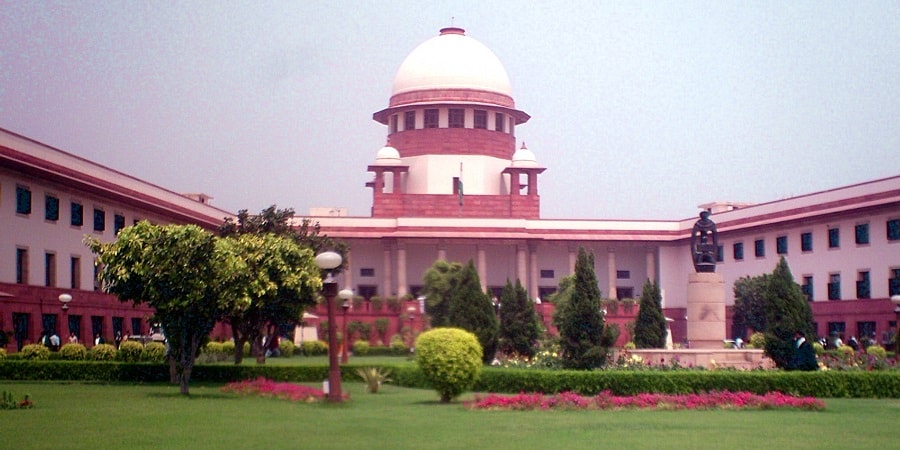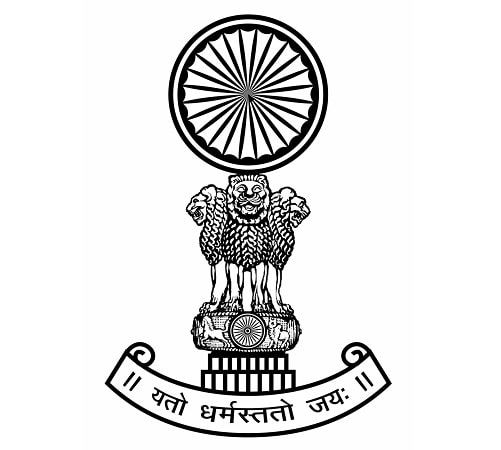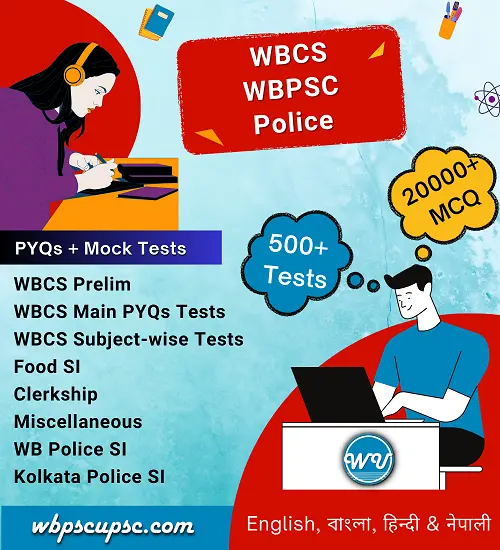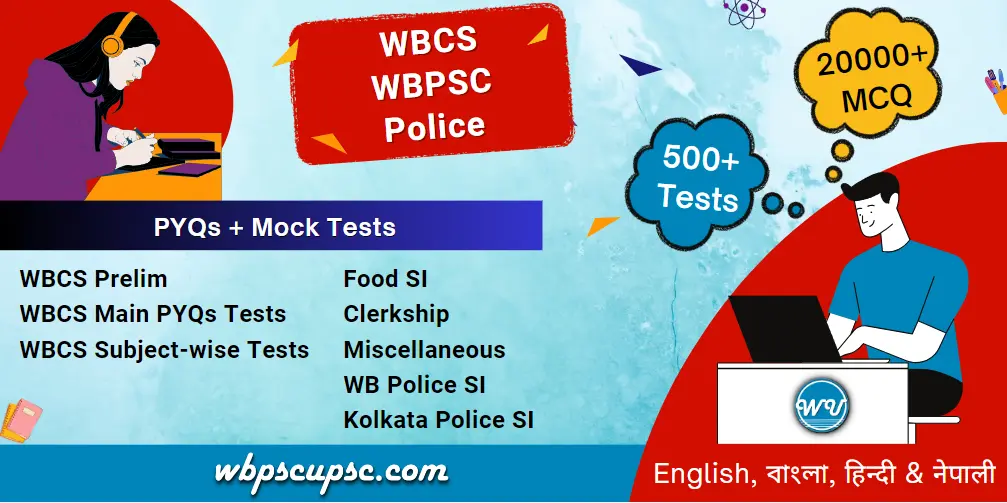Contents
Supreme Court of India
- Article 124 to 147 Part V
- Indian Constitution has an integrated judicial system.
- Supreme court of India at the top and the high courts below it.
- Under a High court, there is a hierarchy of subordinate courts, that is, district courts and other lower courts.
- This single system of courts, adopted from the Government of India Act of 1935.
- In USA, on the other hand, the federal laws are enforced by the federal judiciary and the state laws are enforced by the state judiciary.
- There is thus a double system of courts in USA.
- The Supreme Court of India was inaugurated on Jan 28, 1950.
- It succeeded the Federal Court of India, established under the Government of India Act of 1935.
- Supreme Court of India has replaced the British Privy Council as the highest court of appeal.
- Supreme Court of India is a federal court.
- The highest court of appeal.
- The guarantor of the fundamental rights.
- Final interpreter and Guardian of the Constitution.
>>>>>>

>>>>>>
Organization of Supreme Court of India
- At present, the Supreme Court of India consists of 34 judges (1 chief justice and 33 other judges).
- In 2019, Parliament passed a bill which seeks to increase the strength of judges in the Supreme Court of India from 31 to 34.
- In Feb 2009, the centre notified an increase in the number of Supreme Court judges from 26 to 31.
- Originally, the strength of the Supreme Court was 8 (1+7).
Judges of Supreme Court of India
- The judges of the Supreme Court of India are appointed by the President.
- The chief justice is appointed by the President after consultation with such judges of the Supreme Court and high courts as he deems necessary.
- Other judges are appointed by president after consultation with the chief justice and such other judges of the Supreme Court and the high courts as he deems necessary.
- The consultation with Chief justice is compulsory in the case of appointment of a judge other than Chief justice.
1st Judges case (1982)
- The Court held that consultation does not binding and it only implies exchange of views.
2nd Judges case (1993)
- It ruled that the advice tendered by the Chief Justice of India is binding on the President for appointment of Supreme Court and High Court Judges
- Chief Justice would tender his advice on the matter after consulting two of his seniormost colleagues.
3rd Judges case (1998)
- The Court opined that the consultation process to be adopted by the Chief justice of India requires ‘consultation of plurality judges’.
- He should consult a collegium of 4 seniormost judges of the Supreme Court for appointment of Supreme Court and High Court judges
- If two judges give an adverse opinion, he should not send the recommendation to the government.
4th Judges case (2015)
- Court has declared both the 99th Constitutional Amendment as well as the NJAC Act as unconstitutional and void.
- The court opined that NJAC would affect the independence of the judiciary.
Appointment of Chief Justice of India
- From 1950 to 1973, the practice has been to appoint the seniormost judge of the Supreme Court of India as the chief justice of India.
- This established convention was violated in 1973 when A N Ray was appointed as the Chief Justice of India by superseding three senior judges.
- In 1977, M U Beg was appointed as the chief justice of India by superseding the then senior-most judge
- In the Second Judges Case (1993), Supreme Court ruled that the seniormost judge of the Supreme Court should alone be appointed to the office of the chief justice of India.
Qualification of Chief Justice of India
- A citizen of India.
- He should have been a judge of a High Court for 5 years, or
- He should have been an advocate of a High Court for 10 years, or
- He should be a distinguished jurist in the opinion of the president.
- No minimum age
Oath or Affirmation
- Subscribe an oath or affirmation before the President, or some person appointed by him for this purpose.
- to bear true faith and allegiance to the Constitution of India
- to uphold the sovereignty and integrity of India
- to duly and faithfully and to the best of his ability, knowledge and judgement perform the duties of the Office without fear or favour, affection or ill-will
- to uphold the Constitution and the laws
- Constitution has not fixed the tenure of a judge of the Supreme Court of India.
- He holds office until 65 years.
- Any question regarding his age is to be determined by Parliament.
- He can resign his office by writing to the president.
Removal of Judges of Supreme Court of India
- The President can issue the removal order only after an address by Parliament has been presented to him in the same session.
- The address must be supported by a special majority of each House of Parliament.
- The grounds of removal are two
- Proved misbehavior
- Incapacity
- Judges Enquiry Act (1968) regulate the procedure by the process of impeachment.
- Impeachment Process
- A removal motion signed by 100 members in Lok Sabha or 50 members in Rajya Sabha given to Speaker/Chairman.
- Speaker/Chairman may admit the motion or refuse it.
- If it is admitted, then Speaker/Chairman is to constitute a 3 member committee to investigate into the charges.
- The committee should consist of
- the chief justice or a judge of the Supreme Court
- a chief justice of a high court
- a distinguished jurist.
- If the committee finds the judge to be guilty of misbehaviour or suffering from an incapacity.
- After the motion is passed by each House of Parliament by special majority, an address is presented to the president for removal of the judge.
- Finally, the president passes an order removing the judge.
- No judge of the Supreme Court has been impeached so far.
- The first and the only case of impeachment is that of Justice V Ramaswami of the Supreme Court (1991–1993).
- Enquiry Committee found him guilty of misbehavior, but he could not be removed as the impeachment motion was defeated in the Lok Sabha.
- He can resign from his office by writing to the President.
Salaries & Allowances
- The salaries, allowances, privileges, leave and pension of the judges of the Supreme Court are determined by the Parliament.
- They cannot be varied to their disadvantage after their appointment except during a financial emergency.
Acting Chief Justice
- The President can appoint a judge of the Supreme Court as an acting Chief Justice of India
- if office of Chief Justice of India is vacant
- the Chief Justice of India is temporarily absent
- the Chief Justice of India is unable to perform duties
Ad hoc Judge
- When there is a lack of quorum of the permanent judges the Chief Justice can appoint a judge of a High Court as an ad hoc for a temporary period.
- He need to consult with the chief justice of the High Court concerned and previous consent of the president.
- The judge so appointed should be qualified for appointment as a judge of the Supreme Court.
Retired Judges
- At any time, the chief justice can request a retired judge of the Supreme Court or a retired judge of a high court (who is qualified) to act as a judge of Supreme Court for a temporary period.
- He can do so only with the previous consent of the president
- Such a judge is entitled to such allowances as the president may determine.
Seat of Supreme Court of India
- The Constitution declares Delhi as the seat of the Supreme Court.
- Chief justice of India may appoint other place or places as seat of the Supreme Court.
- He can take decision in this regard only with the approval of the President.
Procedure of the Court
- The Supreme Court can, regulate practice and procedure of the Court with the approval of the president.
- Constitutional cases or references made by the President under Article 143 need a Bench of at least 5 judges.
- All other cases are usually decided by a bench consisting of not less than 3 judges.
>>>>>

>>>>>
Independence of Supreme Court of India
Mode of Appointment
- The judges of the Supreme Court are appointed by the President in consultation with the members of the judiciary itself.
- It ensures that the judicial appointments are not based on any political or practical considerations.
Security of Tenure
- They can be removed only in the manner and on the grounds mentioned in the Constitution.
- They do not hold their office during the pleasure of the President.
Fixed Service Conditions
- They cannot be changed after their appointment except during a financial emergency.
Expenses Charged on Consolidated Fund
- All the expenses of the Supreme Court are charged on the Consolidated Fund of India.
- Non-votable by the Parliament.
Conduct of Judges cannot be Discussed
- The Constitution prohibits any discussion in Parliament or in a State Legislature about conduct of the judges of the Supreme Court.
- Except impeachment motion is under consideration.
Ban on Practice after Retirement
- The retired judges of the Supreme Court are prohibited from pleading or acting in any Court or before any authority.
- This ensures that they do not favour anyone in the hope of future favour.
Power to Punish for its Contempt
- The Supreme Court can punish any person for its contempt.
- its actions and decisions cannot be criticised and opposed by anybody.
Freedom to Appoint its Staff
- The Chief Justice of India can appoint officers and servants of the Supreme Court without any interference from the executive.
- He can also prescribe their conditions of service.
Its Jurisdiction cannot be Curtailed
- The Parliament is not authorised to curtail the jurisdiction and powers of the Supreme Court.
- The Constitution has guaranteed to the Supreme Court, jurisdiction of various kinds.
- The Parliament can extend the same.
Separation from Executive
- The Constitution directs the State to take steps to separate the Judiciary from the Executive in the public services.
Jurisdiction & Powers of Supreme Court
Original Jurisdiction
- Article 131
- Supreme Court decides the disputes between
- the Centre and one or more states
- between two or more states.
- In the above federal disputes, the Supreme Court has exclusive original jurisdiction.
Following Conditions are Excluded
- Political nature dispute are excluded from it.
- Any suit brought before the Supreme Court by a private citizen against the Centre or a state cannot be entertained under this.
- A dispute arising out of any pre–Constitution treaty, agreement etc.
- Inter-state water disputes.
- Matters referred to the Finance Commission.
- Adjustment of certain expenses between the Centre and the states.
- Commercial dispute between the Centre and the states.
- Recovery of damages by a state against the Centre.
- In 1961, the first suit, under the original jurisdiction of the Supreme Court.
- It was brought by West Bengal against the Centre, in validity of the Coal Bearing Areas (Acquisition and Development) Act, 1957.
Writ Jurisdiction
- Supreme Court is empowered to issue writs including habeas corpus, mandamus, prohibition, quo-warrento and certiorari for the enforcement of the fundamental rights.
- High courts are also empowered to issue writs.
- If Fundamental Rights of a citizen are violated, the aggrieved party has the option of moving either the high court or the Supreme Court directly.
- The Supreme Court can issue writs only for the enforcement of the Fundamental Rights.
- But, High court, can issue writs not only for the enforcement of the fundamental rights but also for other purposes.
- writ jurisdiction of the high court is wider than Supreme Court.
- Parliament can confer on the Supreme Court, the power to issue writs for other purposes also.
Appellate Jurisdiction
- The Supreme Court is primarily a court of appeal and hears appeals against the judgments of the lower courts.
- It enjoys a wide appellate jurisdiction which can be classified under four heads.
Constitutional Matters
- An appeal can be made to the Supreme Court against the judgment of a high court if the high court certifies that the case requires interpretation of the Constitution.
Civil Matters
- In civil cases, an appeal lies to the Supreme Court from any judgment of a high court if the high court certifies –
- that the case involves a substantial question of law of general importance
- that the question needs to be decided by the Supreme Court
- Monetary limit was removed by the 30th Constitutional Amendment Act of 1972.
Criminal Matters
- In 1970, the Parliament had enlarged the Criminal Appellate Jurisdiction of the Supreme Court.
- Accordingly, an appeal lies to the Supreme Court from the judgment of a high court, if the high court convicted the accused person and sentenced him to imprisonment for life or for 10 years.
Appeal by Special Leave
- The Supreme Court is authorised to grant in its discretion special leave to appeal from any judgement in any matter passed by any court or tribunal in the country except military tribunal and court martial.
Advisory Jurisdiction
- Article 143 authorises the President to seek the opinion of the Supreme Court of India in two categories
- On any question of law or fact of public importance which has arisen or likely to arise.
- On any dispute arising out of any pre-constitution treaty, agreement, covenant, engagement, sanador other similar instruments.
- In the first case, the Supreme Court may tender or may refuse to tender its opinion to the president.
- But, in the second case, the Supreme Court ‘must’ tender its opinion to the president.
- In both the cases, it is not binding on the president.
- It also known as consultative jurisdiction.
A Court of Record
- The judgements, proceedings and acts of the Supreme Court are recorded for perpetual memory and testimony.
- These records are admitted to be of evidentiary value and cannot be questioned when produced before any court.
- They are recognised legal references.
- Supreme Court has power to punish for contempt not only of itself but also of high courts, subordinate courts and tribunals.
- The expression ‘contempt of court’ has not been defined by the Constitution.
- The expression has been defined by the Contempt of Court Act of 1971
- Contempt of court may be civil or criminal.
- Civil contempt means wilful disobedience to any judgment, order, writ or other process of a court.
- Criminal contempt means
- scandalises or lowers the authority of a court.
- prejudices or interferes with the due course of a judicial proceeding.
- interferes or obstructs the administration of justice in any other manner.
Power of Judicial Review
- Judicial review is the power of the Supreme Court to examine the Constitutionality of legislative enactments and executive orders.
- If they are found to be violative of the Constitution (ultra-vires), they can be declared as illegal, unconstitutional and invalid (null and void)
Other Powers
- Supreme Court of India decides the disputes regarding the election of the president and the vice president.
- It has the original, exclusive and final authority on this matter.
- Supreme Court of India has power to review its own judgement or order.
- It is authorised to withdraw the cases pending before the high courts and dispose them by itself.
- Supreme Court of India can also transfer a case or appeal pending before one high court to another high court.
- It has power of judicial superintendence and control over all the courts and tribunals functioning in the entire territory of the country.
Advocates of Supreme Court
Senior Advocates
- The Court can designate any Advocate, with his consent, as Senior Advocate if in its opinion by virtue of his ability, standing at the Bar or special knowledge or experience in law the said Advocate is deserving of such distinction.
- A Senior Advocate is not entitled to appear without an Advocate-on-Record in the Supreme Court or without a junior in any other court or tribunal in India.
Advocates-on-Record
- Only these advocates are entitled to file any matter or document before the Supreme Court.
- They can also file an appearance or act for a party in the Supreme Court.
Other Advocates
- These are advocates whose names are entered on the role of any State Bar Council maintained under the Advocates Act, 1961.
- They can appear and argue any matter on behalf of a party in the Supreme Court but they are not entitled to file any document or matter before the Court.
Notes
- An impeachment motion for the removal of a judge does not lapse on the dissolution of the Lok Sabha.
- The Inter-State Water Disputes Act of 1956 has excluded the original jurisdiction of the Supreme Court of India in disputes between states with respect to water of inter-state river or river valley.
Supreme Court of India vs Supreme Court of America
| Indian Supreme Court | American Supreme Court |
|---|---|
| Original jurisdiction of Supreme Court of India is confined to federal cases. | Original jurisdiction of Supreme Court of America covers not only federal cases but also cases relating to naval forces, maritime activities, ambassadors, etc. |
| Its appellate jurisdiction covers constitutional, civil and criminal cases | Its appellate jurisdiction is confined to constitutional cases only. |
| It has a very wide discretion to grant special leave to appeal in any matter against the judgment of any court or tribunal (except military) | It has no such plenary power. |
| Supreme Court of India has advisory jurisdiction | Supreme Court of America has no advisory jurisdiction. |
| Its scope of judicial review is limited | Its scope of judicial review is very wide |
| It defends rights of the citizen according to the ‘procedure established by law’. | It defends rights of the citizen according to the ‘due process of law’. |
| Jurisdiction and powers of Supreme Court of India can be enlarged by Parliament. | Jurisdiction and powers of Supreme Court of America are limited to that conferred by the Constitution. |
| It has power of judicial superintendence and control over state high courts due to integrated judicial system. | It has no such power due to double (or separated) judicial system. |
Video Explanation
- Supreme Court of India in Hindi – Part 1
- Supreme Court of India in Hindi – Part 2
- Supreme Court of India in English
>>>>>>>




